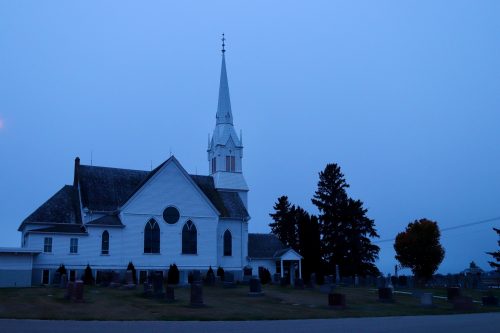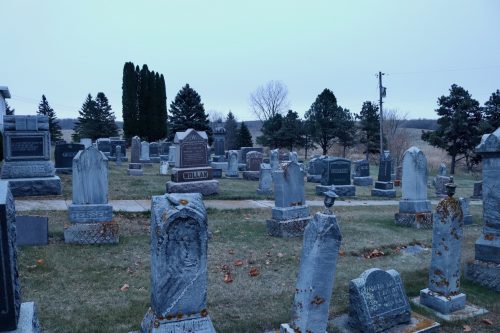I’ve wanted to photograph this spectacular church and graveyard in Starbuck, MN (about 20 miles away from me) for a while, and this morning, on a whim, I decided to drive out early in the morning to explore it. The plan was to catch the sunrise light, maybe get some nice background, but no, the weather did not oblige. Instead, we got a pale gray sky that slowly brightened, uniform and uniformly uninteresting. I took a few shots anyway. Maybe I’ll try again on a different day.
This is the Indherred Lutheran Church, and the steeple declares that it was built in 1896. The graveyard is significantly older, though — I found tombstones from the 1860s, and other stones so eroded they were unreadable. Most of the names were German and Scandinavian, as you’d expect. It’s hard to imagine living in this remote part of the country 160 years ago, when there was probably nothing but a dirt road connecting your tiny community of farmers to markets and civilization; I think the railroads were mainly built in the 1880s and later.
There were some funky tombstones there that made me wonder about the story behind them, like this stone tree-trunk for Swerre Torenius A. Wollan. Yeah, that’s not a rope, it’s sculpted. It’s got spectacular lichen growing on it, too.
The other question in my mind was what language they were speaking. I know a little rusty German, and this ain’t it. Instead of “born” and “died”, we’ve got “fodt” and “dode”. Maybe someone will recognize it. Is this some archaic form of Danish? Some other Scandinavian language?
I couldn’t even guess what this inscription says. It’s tantalizingly germanic, but that’s as far as I can get. Also, lots of the stones had this hand symbology, like the handshake on this one.
I also sent one photo off to [email protected], we’ll have to see if it makes the cut. You know that as part of our fundraiser, we’re inviting everyone to send in photos with a Fall/Halloween theme, right? That means you, too. Maybe your work will end up in our art collection for everyone to see! We also welcome donations to our cause, if you don’t feel like taking pictures.






I find the lighting to be eerily perfect. Reminds me of Night of the Living Dead.
Is Wollan a common name around there? In addition to the tree trunk Wollan, the shot above that has a modern marker with the name Wollan on it.
According to a couple of sites, the handshake is the “Final Handshake” or last farewell to those left behind. It’s deemed one of the most common symbols on Victorian era gravestones.
fodt and dode is danish for born and died.
And the frequency map shows Wollan is most commonly found as a last name in the US in: Minnesota. Norwegian origin.
Google translate says that ‘født’ and ‘dode’ are ‘born’ and ‘died’ in Danish and Norwegian. ‘dode’ also works in Icelandic and Swedish, but ‘fodt’ is ‘foot’ for them.
Both words have umlauts.
Wiktionary lists döde as “absolute definite natural masculine form of död.” And död as Old Swedish for ‘dead.’
This life is merely a wander
Our true home is Heaven
Thereto yearns every brave step
For the road leads to light and peace
Slightly archaic Norwegian
When great great grandpa arrived at Ellis Island from Trondheim they said “square heads go to Wisconsin and Minnesota.” Apparently some idiots in the US immigration system thought that Norwegians would appreciate the weather in Minnesota. Translations from his journal (which was minimalist) included complaints about the mosquitoes.
Indherred (or Innherred) is a district in Trøndelag County, and Langvandet (later Langvatnet) is a lake in Nordland County; both in Norway.
malodious @6 beat me to it. All the stuff is extremely Norwegian, except substituting ‘o’ for ‘ø’.
That’s as you suspect born/died in either Danish or Norwegian. There are few practical difference between the two considering the time period, though I did find a Gunerius Langvandet born 1862 mentioned as son of an emigrant from Snåsa, Norway who left in 1867, that could easily be the same person. Born/died would be written født/døde these days in both languages, but at least for Norwegian I know the ö in place of ø used to be common up until a few decades ago. Definately not Swedish, born is född for instance.
Tombstone of Gunerius reads, with more literal translations in brackets:
Here lies [Hereunder rests]
Gunerius Langvandet
Born
Sept.8,1861
Died
July 23,1882
[A wandering only is life here]
[Our right home in heaven is]
[There (uncertain) every brave (uncertain)]
[for the path goes to light and peace]
Yeah, my family got shipped off to Minnesota as soon as they arrived, and once they discovered there was a fjord with a temperate oceanic climate on the continent, they all hared off West. Same thing for my wife’s family, with their good Norwegian name of “Gjerness” took off for the Pacific Northwest. Good thing, too, or we wouldn’t have met.
Good to see we’ve got a few fellow scandinavians here in the comments!
Whichever language it is, it is not the modern version.
The Scandinavian Languages: Their Histories and Relationships
An ex-pat living in a foreign country might not be aware or observant of a spelling reform in the homeland.
Spelling reform
Per my first link in #12, also note the existence of regional dialects within all the Norse languages.
I am not sure but I might have a bit of Norwegian in my family tree; there is a family name that got translated to a similar-sounding Scottish name on arrival.
Swerre Torenius A. Wollan’s tombstone is the creepiest thing I have ever seen in an actual cemetery. If I ever decide to film a low budget horror flick I have my opening scene.
I know it’s not under the sea, but if you find Smitty Werbenjagermanjensen anywhere here, I heard he is missing his hat.
Reginald Selkirk @14: Not Grieg to Greig by any chance? Funnily enough, the Norwegian name Grieg (e.g. the composer Edvard) is a Norwegianized form of the Scottish name Greig. Link.
I can’t really tell, but if one of the hands is a woman’s hand, then the clasped hands could be a symbol of marital unity.
According to one site, the tree trunk stands for the “brevity of life.” Or it might indicate a member of Woodmen of the World. Whatever it is, it’s winky into the ground.
No, but I prefer to remain pseudonymous.
That first shot is almost a gloomy, early-morning view of the wedding of Mr and Mrs Ralph Hapschatt… somewhere near Denton…
So the church was built in order that the dead could be interred in Indherred, huh?
5, Selkirk:
As a perfectly integrated (americanized) second-(third?-)generation import, PZ doesn’t do extended characters. He cannot even see diaereses when clearly in front of him. Apparently, his inventory of letters is limited to ASCII.</bashing US education>
@20 I also thought it looked like a misspelling of “interred”.
My family’s old cemetery in Iowa also has a tombstone shaped like a tree trunk. There are also plot boundary markers shaped like small upright logs. I should go check it out again and get some pictures. My husband and I bought a big plot out there and invited any family members to join us someday. :) My grandparents and parent (only one so far thankfully) are in the town cemetery, but the country one with the the great-greats and further back is beautiful. It’s on a slight hill overlooking farmland.
The poor, short-lived bloke was born 100 years before me.
Judging by the ambience of the churchyard, Herr Doctor Johannes Cabal may have been there before you.
-How many tombs sported a portable phone with a wire going down in the hole down the steps under the opened slab? Or is that only New England tombstones?
Spike’s crypt in Buffy the Vampire slayer was surprisingly spacious. Did they ever explain where he got power for the TV?
13) @Reginald Selkirk: I lived in Bergen for about two months back in the 80s and when I, who knew almost no Norwegian beyond “tusen takk,” visited Oslo, it was clear even to my ignorant eyes that they spoke a different dialect of Norwegian there, as all the signage was quite different.
19) @Jaws: Hapshit! (been to too many midnight showings ;)) It really does look like that church though. The whole photo is just a big mood. I don’t know what PZ is talking about saying it’s uninteresting. I think it’s beautiful (but I’m partial to blue).
Some background on tree trunk stones in link. Some are due to the “Woodmen of the World” fraternal order, others just because it was a popular design.
https://www.atlasobscura.com/articles/why-gravestones-are-shaped-like-tree-stumps